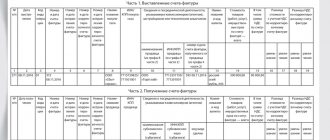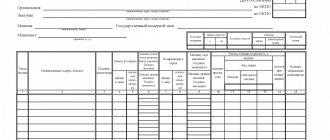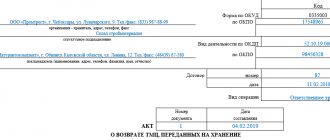Why should they be conducted?
Occupational safety logs are documents that reflect basic information about the state of occupational safety on the territory and workplaces of the enterprise. For what purposes is it necessary to maintain these documents:
- The documentation must reflect information about employees undergoing all types of training, including fire safety. After hiring, the employee must be instructed.
- Registration of occupational diseases and accidents.
- Ensuring that safety instructions are taken into account.
- Accounting for the distribution of materials to workplaces to immediate supervisors.
- Accounting for actual training in the field of occupational safety.
- Testing knowledge in the field of electrical safety.
- Recording OT checks.
- Carrying out inspections of all control levels: 1, 2 and 3.
- Accounting for work according to work orders and orders.
- Conducting medical examinations.
- Providing employees with PPE and RPE. Such protective clothing is issued and at the same time written off to prove that the employee received it.
- Carrying out inspections of ventilation systems.
- Accounting for the issue and serviceability of tools: pneumatic, electric, abrasive and others.
- For hot work, including welding.
- Maintenance of buildings and structures.
- To reflect information about the internship of employees in that other position.
- On the permission of employees to perform labor duties independently.
- To transfer orders to perform duties to other officials.
- To control records of employee incentives.
- To ensure safety control in all areas, it is necessary to record all information.
Answers to your questions
What are the standards for issuing PPE?
An engineer for setting up and testing electrical equipment (charging and rectifying devices, DC switchboards) checks the functionality of the equipment after assembly. The work is carried out indoors. According to what standard industry standards should PPE be issued to a worker, if the risk of an electric arc is unlikely - for cross-cutting professions or by order of the Ministry of Health and Social Development of Russia dated April 25, 2011 No. 340 (clause 176)?
You need to rely on the order of the Ministry of Health and Social Development of Russia dated April 25, 2011 No. 340. It is necessary to issue those PPE that are used indoors. Even if you assess the likelihood of an arc occurring as low.
Is it possible to combine instructions?
Is it allowed to combine and document instructions on labor protection, fire safety, and electrical safety in the occupational safety journal?
It is not prohibited to conduct simultaneous briefings on labor protection, fire safety and electrical safety. However, it is practically difficult to combine them. The questions discussed are different, and the briefing may be unnecessarily prolonged. Therefore, its effectiveness will be low: the employee may get tired of the volume of information and not understand or remember something. This will increase the likelihood of employee injury.
It is recommended to keep separate logs of occupational health and fire safety briefings.
Does a part-time worker need to undergo electrical safety certification?
The employee performs the duties of a person responsible for lifting structures and electrical safety in two organizations. In one of them he is a part-time worker. Does he need to undergo electrical safety certification in both organizations or is it enough to have permission to work only at his main place of work?
In agreement with the State Energy Supervision Authority, a part-time worker who will be appointed responsible for electrical facilities may not have to conduct an electrical safety knowledge test. To do this, three conditions must be met:
- if no more than 6 months have passed since the knowledge test in the State Energy Supervision Commission as administrative and technical personnel for the main work;
- the energy intensity of electrical installations, their complexity in a part-time organization is no higher than at the place of main work;
- The organization part-time does not have electrical installations with voltages higher than 1000 V (clause 1.4.29 of the Rules for the technical operation of consumer electrical installations, approved by Order of the Ministry of Energy of Russia dated January 13, 2003 No. 6).
List of required occupational safety magazines at the enterprise
The following documents must be kept:
- magazine for conducting introductory briefings;
- documents on other types of briefings: repeated and targeted;
- on the issuance of personal protective equipment;
- registration of a special assessment of working conditions;
- registration of occupational diseases and accidents;
- inspection of lifting devices;
- accounting for slings and lifting mechanisms;
- magazine on cleaning dust collectors and ventilation systems;
- a journal that records the assessment of employees' occupational safety knowledge;
- maintaining 1st and 2nd stages of control.
Rules for filling out the occupational safety journal
According to regulations, there are some rules for keeping logs, namely:
- At enterprises, it is recommended to develop a local document in which it is worthwhile to prescribe how to fill out certain logs, so that there is a uniformity of approach.
- It is undesirable to make typos or blots; if there are any, you must carefully cross out unnecessary information, write an asterisk next to the word, and at the bottom make a footnote “believe corrected.” Be sure to sign and date when it was signed. It is important to know that a signature without a date will not be considered valid.
- Each column must be filled out in a timely manner.
- On the title page of any journal, you must indicate the full name of the organization, as well as write down the name of the service in which it is maintained.
- It is advisable to avoid blots and corrections.
How to fill out a log of occupational safety instructions, see this story:
What should the enterprise have?
One enterprise may have several electrical safety magazines.
Depending on the specifics of the enterprise, the list of journals differs, but the basic forms do not change:
- accounting for the assignment of 1st electrical safety group to non-electrical personnel -;
- accounting for testing knowledge and standards for working in electrical installations - sample;
- registration of induction training. This is carried out for employees before starting work and concerns general safety rules when working with electrical installations - download a sample;
- taking into account the training carried out at the workplace;
- recording of industrial accidents;
- operational log - kept at distribution panels and control centers;
- accounting and issuance of keys to electrical installations;
- electricity metering. This document records all electricity costs and income, as well as the results of actions taken to reduce electricity consumption;
- accounting of protective equipment. When working on an electrical installation, certain means of protection against electric shock are used. It is necessary to keep records of them;
- issuance of permit orders when working in electrical installations - sample.
Each of the journals should be maintained in accordance with the rules and regulations of the law. The enterprise must have a responsible person who is responsible for filling out the log.
If it is not there, then the regulatory authorities may well impose an administrative penalty or even a criminal one if there are victims of the accident.
Who fills out the logs?
Electrical safety logs must be maintained by a responsible person who is authorized to do so. At the same time, the manager necessarily controls how exactly the document is maintained and how it is stored.
Most often, a person responsible for electrical equipment is appointed to manage it. In many enterprises, this position is given to the chief electrician.
The inspection person must have a designated electrical safety group and permission to keep logs from management.
Moreover, such an employee does not have to have a special electrical engineering education; it is enough to study at Rostechnadzor courses for 72 hours.
Filling Features
First of all, when filling out journals, you need to pay attention to the title page. The correctness of the information it contains is important.
The title page reflects the full name of the company, as well as the name of the document, depending on its specific purpose.
The title page also contains information about the start and end dates of journaling.
It also indicates the details of the employee who is responsible for filling it out correctly.
The magazine needs to be stitched and laced. The ends of the lacing must be secured with adhesive on which the company seal is located.
Otherwise the book may be considered invalid. Not far from the press, information about the number of pages is recorded. All pages in the document must be numbered. This is done so that it is not possible to remove or add pages.
The log must be filled out strictly according to the rules. Most often, the document is filled out in the form of a table. Any filling must be completed with the signature of the responsible person.
If there is a log at the production site, then if an accident occurs, it will confirm the fact that occupational health and safety were taken seriously at the production site. This can reduce consequences and reduce sanctions, both on officials and on the legal entity.
Download samples
A set of sample magazines on electrical safety - .
How to lace and number correctly
No matter how many pages a document contains, they must all be numbered, with numbering starting from the first sheet.
Several rules for filling out the document:
- number all pages;
- write the name of the production site;
- on the title page write on what date the journaling began and leave space for the date when it will be completed.
Firmware for the document is required. To do this, use an awl to make two holes, 3/4 away from the bottom of the page. Threads are threaded through the holes and pulled to the last page, tied into a knot, while it is necessary to leave two free ends that will stick to the paper. The pasted tracing paper must be affixed with the seal of the organization and the signature of the clerk. Next you need to write the number of sheets.
A journal is a document and must be taken into account in office work: the document must be assigned a registration number.
All of the above recommendations must be followed.
Printing Features
Magazines are printed mainly on coated paper: glossy or matte. Each type has its own advantages, for example, glossy paper reduces the use of paint, it is smoother, and has low dusting. In addition, when printing, loose ink rarely transfers to subsequent pages, meaning there is no set-off. Glossy magazines feature vibrant images.
Matte paper is tougher, but more pleasant to the touch, it is less transparent, and therefore is well suited for literary magazines and publications with a lot of text. An intermediate type of coated paper, called semi-matte, is also used for printing magazines. It combines the positive aspects of both types.
Magazines are quite colorful publications, and therefore great importance is attached to color. This indicator determines how many colors from the CMYK or Pantone palette will be used on the page. The most commonly used color is 4+4, which means that both the front and back sides will receive 4 colors. In any case, the color values for individual pages have a 1:1 ratio, since both sides are of equal importance in the magazine.
Registration requirements
List of mandatory requirements for maintaining a journal:
- There must be a record that the employee is familiar with the relevant conditions.
- If the calendar year is over, but the journal is not, then it is necessary to draw a line to this end.
- Items must be numbered from the beginning of the year.
- Before using a document, it must be numbered.
- The firmware is supposed to be installed from the title page.
- The magazine needs to be stitched with a special thread.
- The last page requires the signature of the clerk, with a seal applied on top.
In general, the design requirements are set out in the state standard, and can also be taken into account in the Regulations for the enterprise.
How to properly prepare a journal for issuing certificates
Although no formalized document has been developed on what columns should be contained in the journal, in any case it is recommended:
- Develop a uniform management form for the enterprise, approved by regulations.
- Print documents using a single form in a printing house.
Magazine title page
How to fill out the fields:
- first column - the serial number is indicated;
- in the second column the number when the certificate was issued is written;
- in the third - the serial number of the certificate;
- in the fourth - the number of the certificate in order;
- the fifth column contains information about the employee who received the certificate;
- in the sixth, the position of a specialist is indicated, according to the staffing table;
- the seventh contains information about the place of work, department;
- in the eighth it is allowed to leave space for a note (additional information).
How to properly keep a log of workplace briefings
In order No. 1/29, the log form is not given, but it is necessary to take into account the instructions. Therefore, the employer has the right to use documents from GOST, methodological recommendations, or develop them himself. For example, a sample journal is given in Appendix A to GOST 12.0.004-2015 “System of occupational safety standards. Organization of occupational safety training. General provisions."
Sample of filling out the workplace briefing log
How to fill out the journal correctly: instructions
- Please provide the full name of the organization
- Indicate the journal number. If there are several divisions, then keep such a log in each division. But if the company is small, you can keep one journal
- Indicate the name of the department according to the staffing table
- Set the start date for logging. Record the end date of the journal before storing the journal, after the last entry in the journal is completed
- In the “Date” column, enter the entry in the format DD.MM.YY or DD.MM.YYYY. There will be no violation in this
- Please indicate the full name of the person being instructed. This can correctly identify the employee who has undergone the training. If you employ foreigners whose documents do not indicate a middle name, you can also omit the middle name. For example, citizens of Ukraine may not indicate their middle name in documents
- Enter year of birth in YYYY format
- Please indicate your profession and position according to the staffing table
- Correctly indicate the type of instruction
- In the column “Reason for conducting an unscheduled briefing”, make an entry only for an unscheduled briefing; in this field, indicate the number and date of the order. There is no need to write down “In connection with the entry into force of the Rules on labor protection during the operation of electrical installations...”. Each unscheduled briefing and extraordinary knowledge test is carried out by order of the employer. His instructions will be sufficient.
- The profession or position of the instructing person - the head of the department or the workshop foreman, appointed by order to be responsible for conducting the instruction, must also be indicated in accordance with the staffing table, but the full name can be written in the format “Last name, initials”
- Due to the rush, many people confuse columns 8 and 9, indicating the signature of the worker in column 8, and the signature of the foreman in column 9. If such an error occurs, do not cross out the inscription. Just write the correct entry on the next line
- Information about the internship should be provided only during the initial briefing on labor protection
0
0
What are the retention periods for logs?
Depending on the purpose, OT magazines have different shelf life, for example:
- Registrations of occupational diseases cannot be destroyed; they must be stored indefinitely.
- Storage of logs that reflect information about briefings is ensured for at least 10 years.
- Documents that prescribe the imposition of administrative penalties and fines are stored for 3 years.
The storage periods for logs can be regulated by the administrative document of the enterprise.
Procedure
The basic requirements for the design of records maintained in an appropriate manner are necessary in order to exclude the falsification of a document by setting the wrong date for the creation of a document, or by getting rid of a document that was produced earlier.
That is why the magazine should be compiled and produced as follows :
- The logbook must be stitched;
- The complete numbering of sheets must be observed, starting from the first and ending with the last;
- at the end of it there should be a phrase stating that it is stitched and numbered with a certain number of sheets (depending on the document), as well as the initials and personal signature of the director;
- The seal of the organization itself must be located under the director’s signature.
As for the cover, it doesn’t matter much whether it is hard or soft. Of course, the best option is still a hard cover, in terms of the safety of the document itself, because it is stored for 75 years, i.e. exactly the same period as the documents themselves that were taken into account.
About special magazines
Along with the main documents, the enterprise maintains special-purpose papers, for example, this is a log of the issuance of certificates. According to regulations, all specialists and employees in their areas of activity must undergo training programs in order to be allowed to perform work. After employment, organization of events is necessary, and everything should be organized within the first month.
Programs are developed based on industry affiliation, as well as labor conditions and the nature of the work. The list is approved by the administrative act of the organization.












